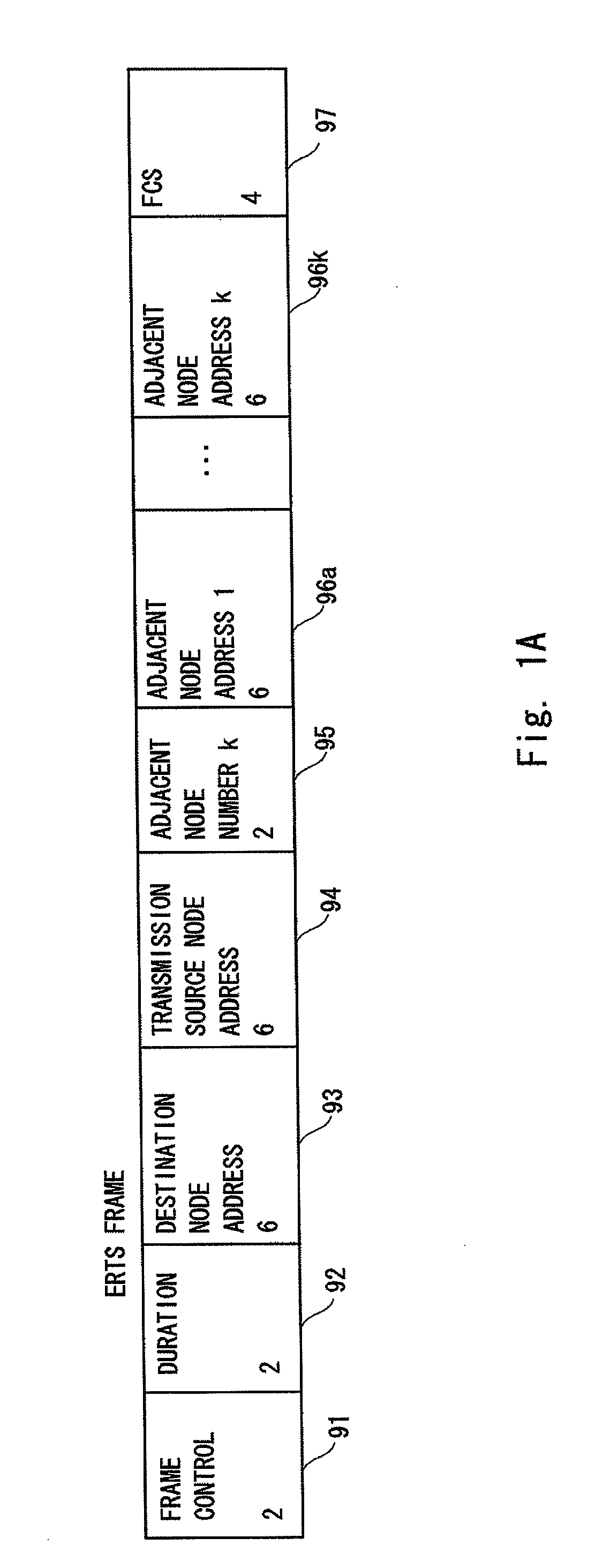Radio communication device, radio communication method, and radio communication program
a radio communication device and radio communication technology, applied in the direction of network topologies, climate sustainability, sustainable buildings, etc., can solve the problems of radio interference, radio communication performance degradation, radio communication delay, etc., to prevent the degradation of power consumption efficiency of radio communication devices, the effect of prolonging the operating time of radio communication devices
- Summary
- Abstract
- Description
- Claims
- Application Information
AI Technical Summary
Benefits of technology
Problems solved by technology
Method used
Image
Examples
first exemplary embodiment
[0095]When radio communication devices according to the present invention perform data transmission and reception, a radio communication device of transmission source node transmits a control frame corresponding to an RTS frame (hereinafter referred to as ERTS frame) setting a node address of a radio communication device to which the data is transmitted as a destination. The radio communication device that has received the ERTS frame transmits a control frame corresponding to a CTS frame (hereinafter referred to as ECTS frame) setting the radio communication device that has transmitted the ERTS frame as a destination. The ERTS (Enhanced-RTS) frame and the ECTS (Enhanced-CTS) frame have the control frame data structure according to the present invention, and are different from an RTS frame and a CTS frame according to a related art.
[0096]The radio communication device according to the present invention functions as a node that transmits and receives data in a radio communication syst...
second exemplary embodiment
[0197]Next, the second exemplary embodiment according to the present invention will be described. Note that the data structure of the ERTS frame and the ECTS frame transmitted and received by the nodes (radio communication devices) according to the second exemplary embodiment is the same as that of the first exemplary embodiment.
[0198]FIG. 6 is a block diagram showing a configuration example of a node (radio communication device) according to the second exemplary embodiment. In the second exemplary embodiment, the node 51 includes a node control device 2, a data processing device 3, a first radio transmission / reception device 4, and a second radio transmission / reception device 5. The components identical to those of the first exemplary embodiment are denoted by the identical reference symbols, and the detailed description will be omitted.
[0199]The second exemplary embodiment is different from the first exemplary embodiment in that the node 51 includes a first radio transmission / rece...
first exemplary example
[0260]Next, the first exemplary example of the present invention will be described with reference to the drawings. The first exemplary example corresponds to the first exemplary embodiment of the present invention.
[0261]The first exemplary example will be described by taking the radio communication system shown in FIGS. 5A and 5B as an example. The radio communication system shown in FIGS. 5A and 5B is ad-hoc network having no device that collectively manages the communication control of the nodes such as the access point. The description will be made on a case in which the transmitting node (4) transmits data to the receiving node (3).
[0262]Further, in the first exemplary example, the number of adjacent nodes that can be specified in the ERTS frame and the ECTS frame is k=2 at a maximum, and the ERTS frame and the ECTS frame have fixed lengths.
[0263]Further, in the first exemplary example, a case of employing the active scanning method will be described. The node searches the adjac...
PUM
 Login to View More
Login to View More Abstract
Description
Claims
Application Information
 Login to View More
Login to View More - R&D
- Intellectual Property
- Life Sciences
- Materials
- Tech Scout
- Unparalleled Data Quality
- Higher Quality Content
- 60% Fewer Hallucinations
Browse by: Latest US Patents, China's latest patents, Technical Efficacy Thesaurus, Application Domain, Technology Topic, Popular Technical Reports.
© 2025 PatSnap. All rights reserved.Legal|Privacy policy|Modern Slavery Act Transparency Statement|Sitemap|About US| Contact US: help@patsnap.com



